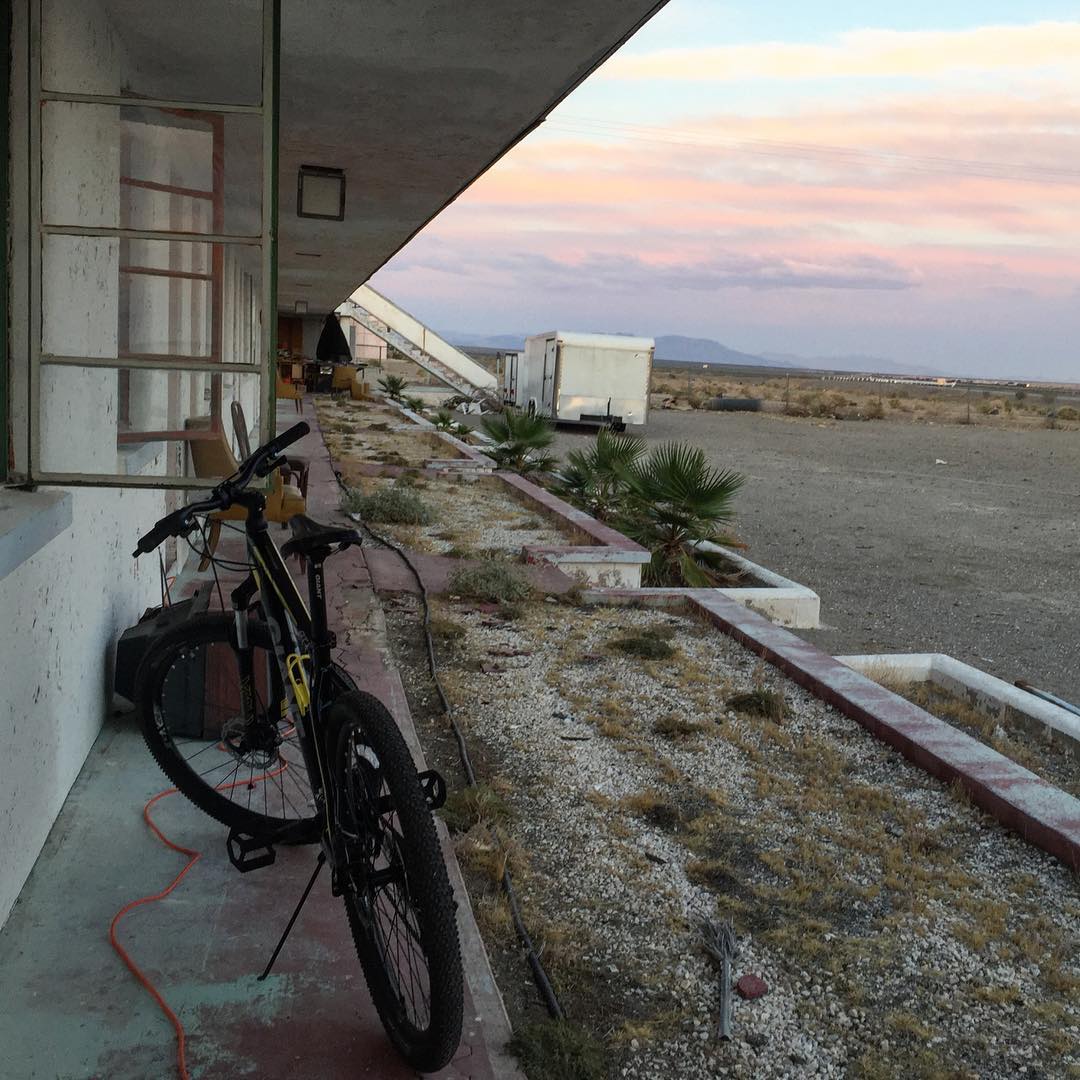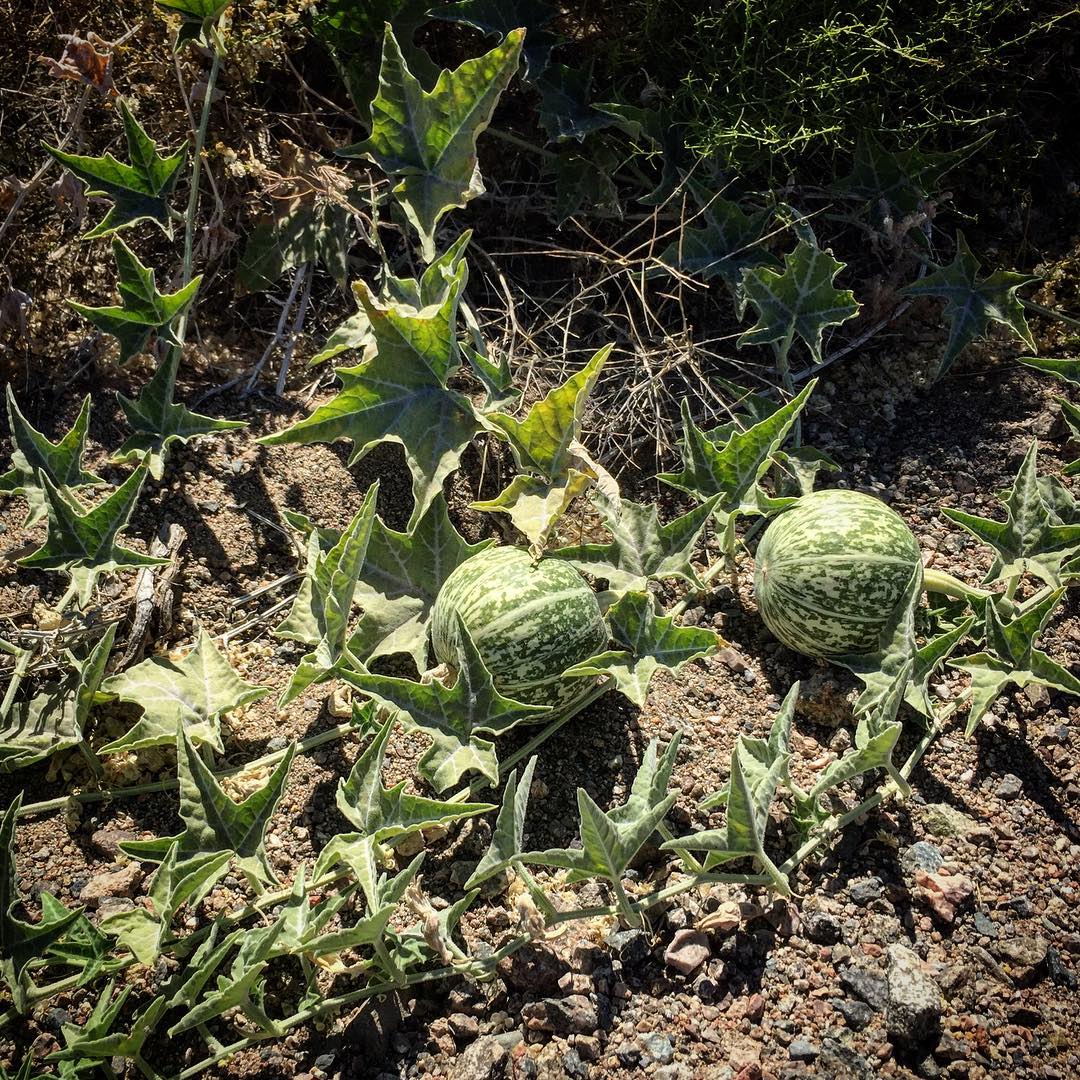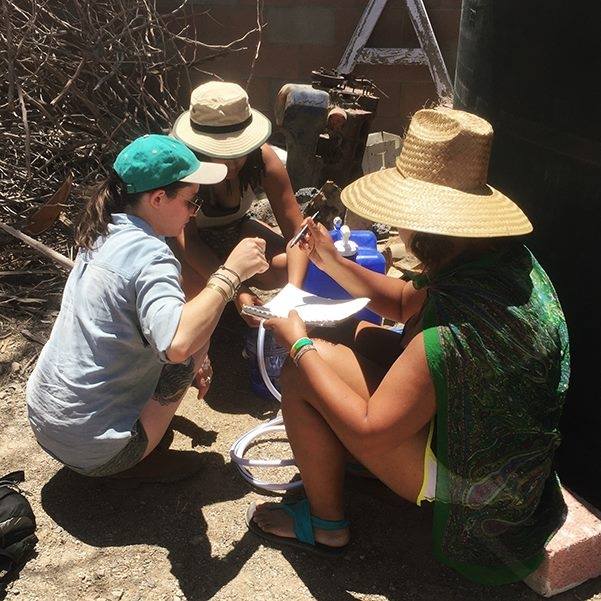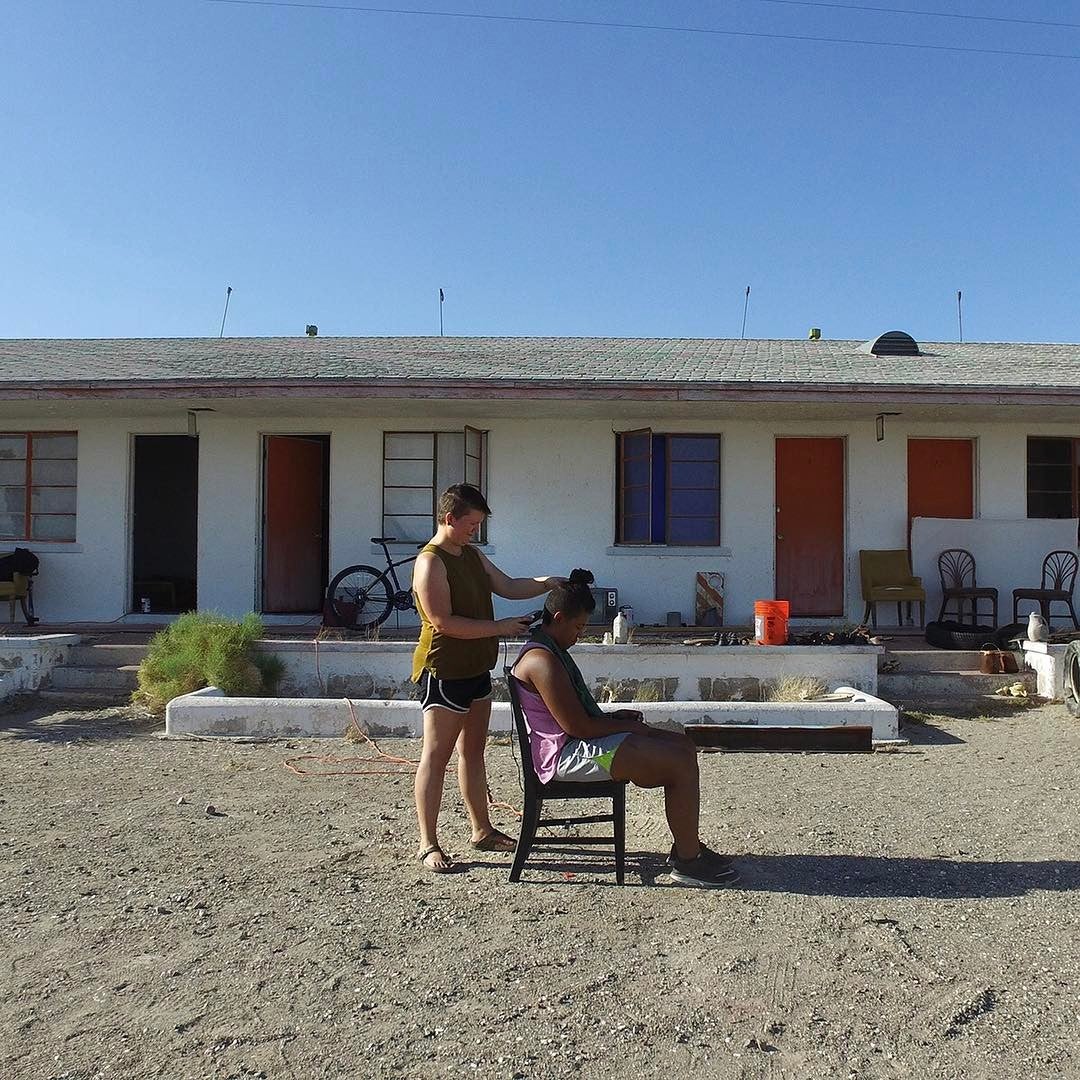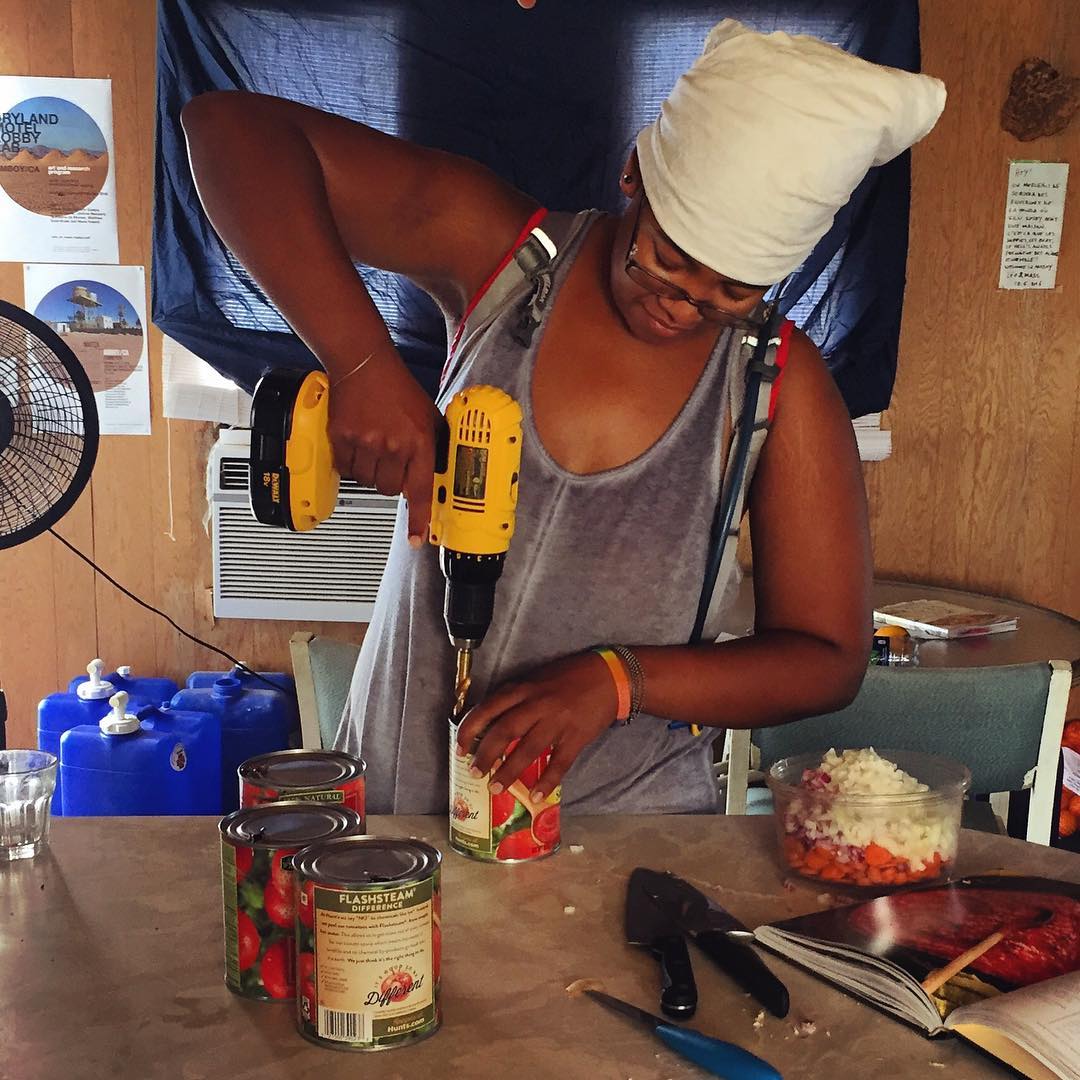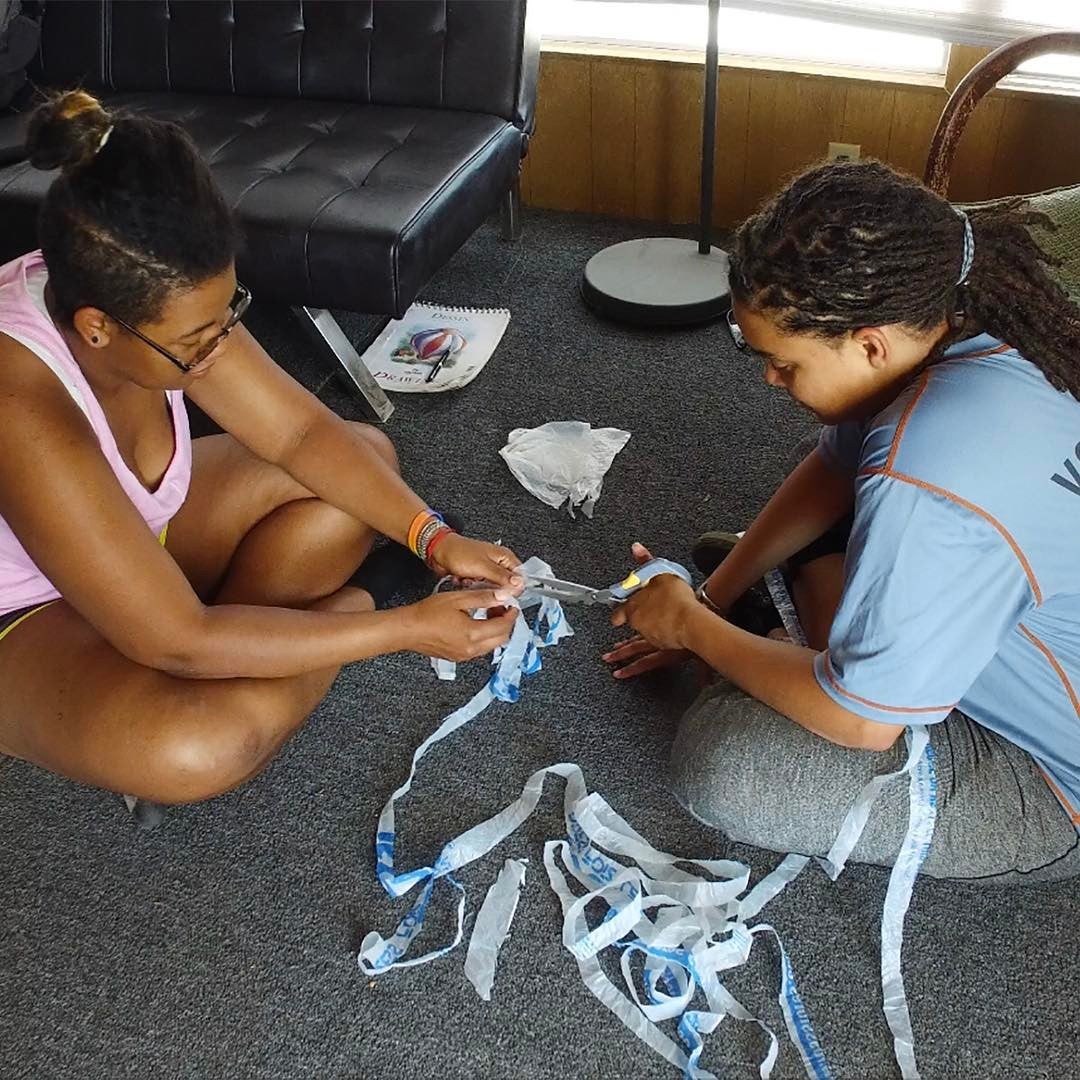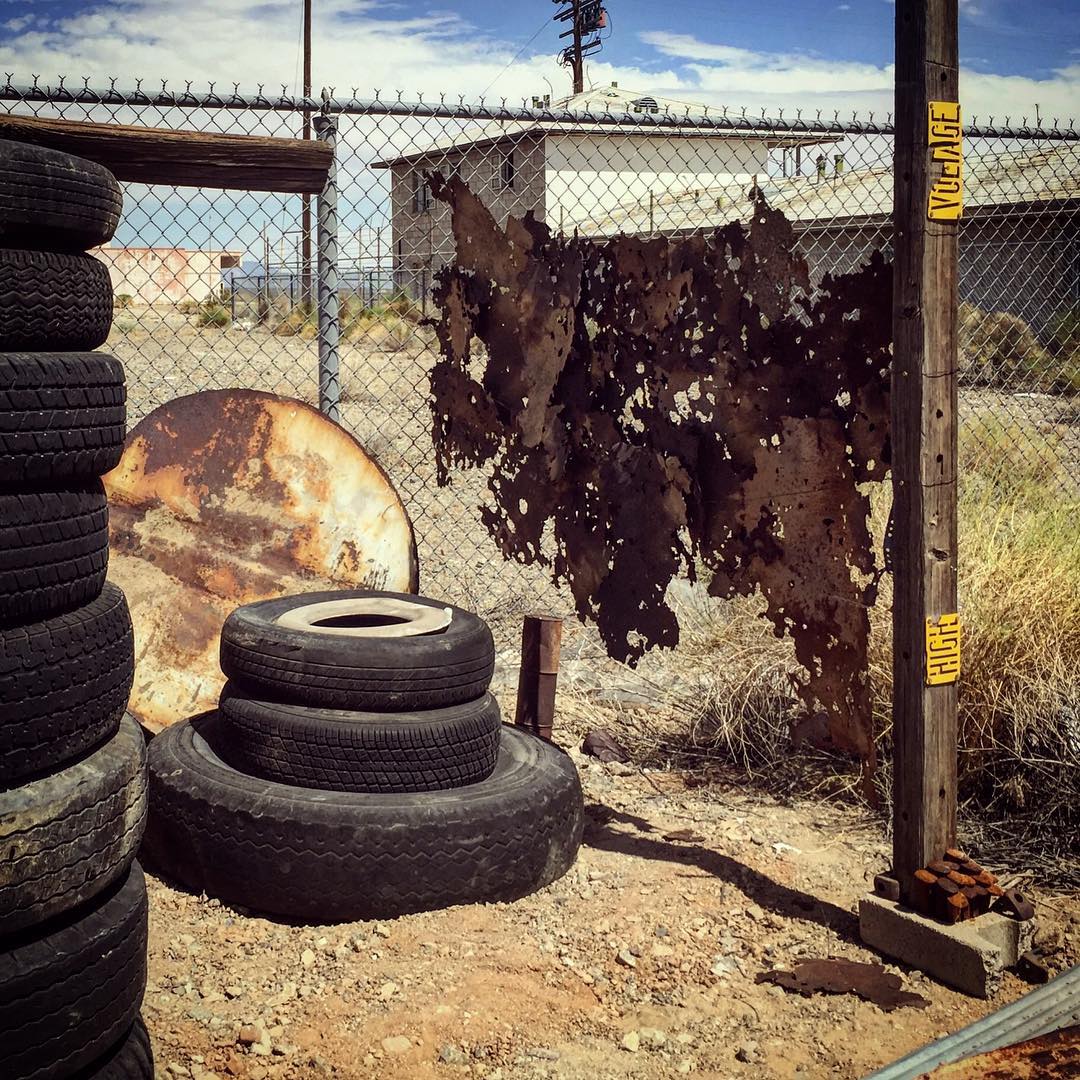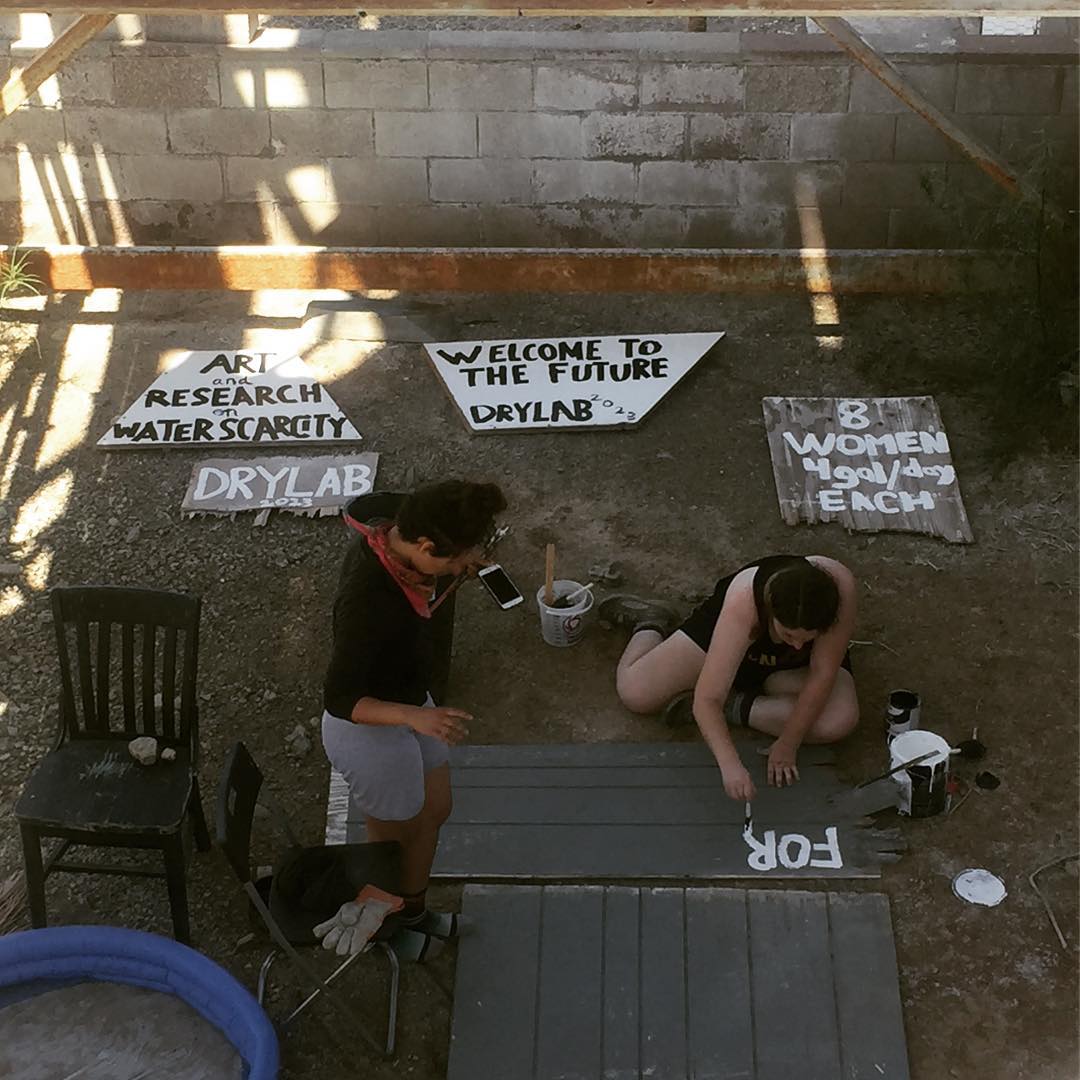8 people, 30 days and 100 degrees in the Mojave desert: An ASU water experiment to remember
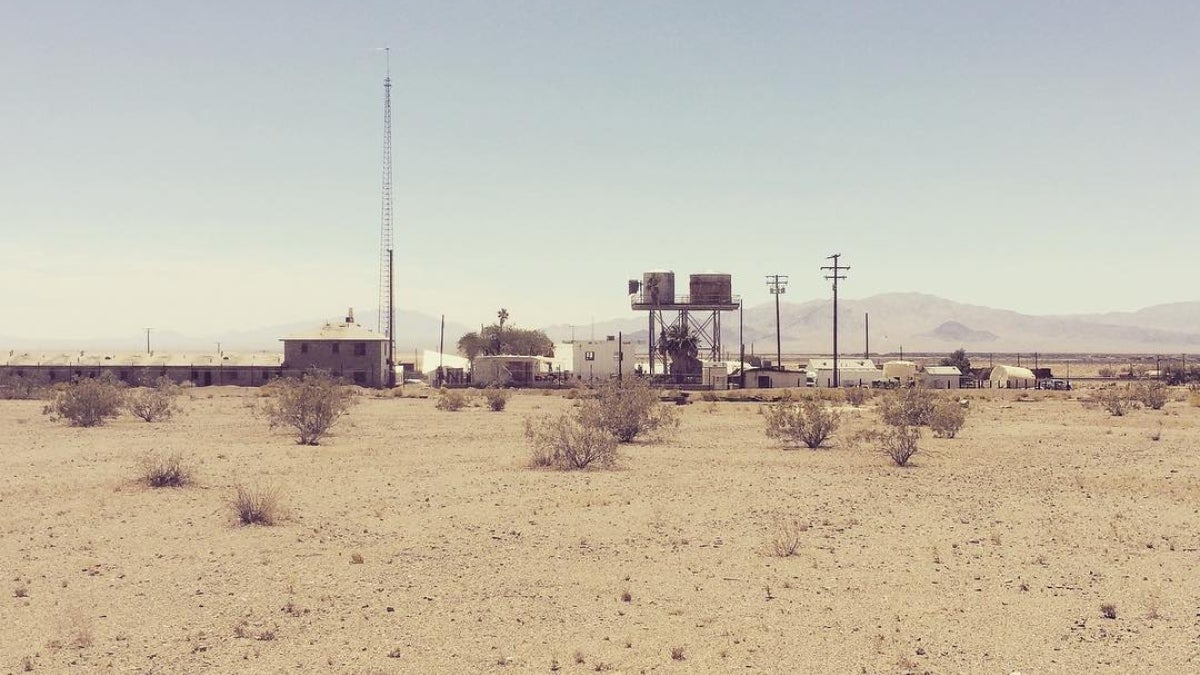
Editor's note: This story is being highlighted in ASU Now's year in review. To read more top stories from 2017, click here.
“What is it, Major Lawrence, that attracts you personally to the desert?”
“It’s clean.”
— “Lawrence of Arabia,” 1962
Bring eight people together for a month in an almost-abandoned hamlet in the middle of the Mojave desert, restrict them to four gallons of water per day each, and see what happens.
That was the project, a hybrid science-art experiment. It started off as a water exercise and became a study in cooperation that none of them expected. None of them will ever forget it, either.
“I don’t think everyone knew what they were in for,” said a student.
“It was a really profound experience for all of us,” said one of the faculty. “It exceeded all our expectations of what was going to happen to us.”
The genesis
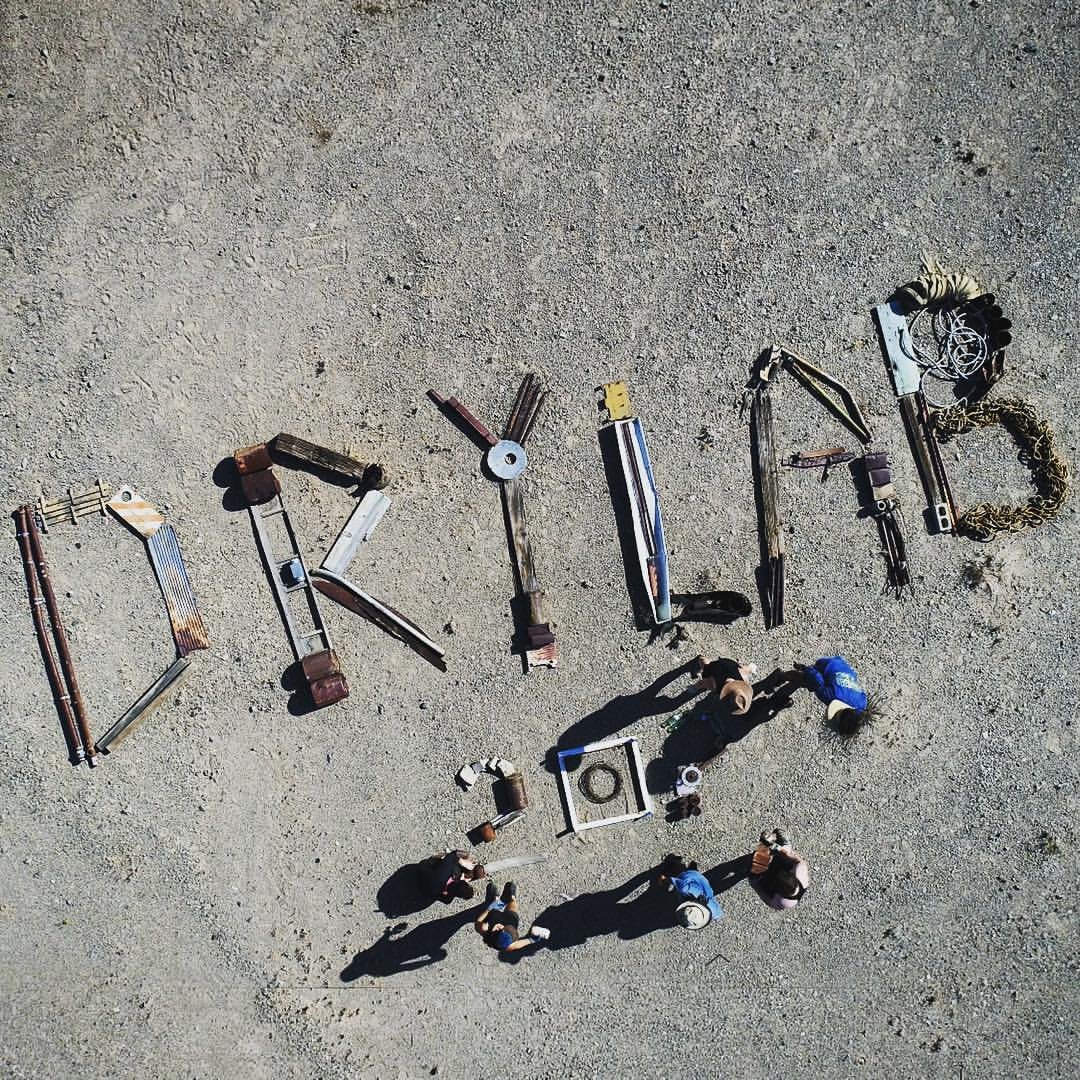
The group of eight Drylab2023 participants assembled the words of the project from refuse gathered near the site. This image was shot with a drone. Photo courtesy of Drylab2023.net
Drylab 2023 was co-directed by two Arizona State University faculty members, Marco Janssen and Adriene Jenik.
Janssen, director of the Center for Behavior, Institutions and the Environment and a professor in the School of Sustainability, met a Swiss artist who ran a project bringing artists and scientists together in extreme environments. Think Tunisia, Swiss alpine glaciers and the Mojave desert. The Swiss artist offered the Mojave space to Janssen.
Janssen contacted co-director Adriene Jenik, a professor of intermedia in the Herberger Institute for Design and the Arts.
“We began to hatch the idea,” Jenik said. “We were interested in working together to see how art and science could complement each other, but a bit more open-ended than a typical scientific experiment. ... We decided to create a near-future fictional scenario where we could monitor the amount of resources.”
The scenario
Sunrise, viewed from the front of the dilapidated motel where the project was sited. Each participant had her own room, which had electricity but no air-conditioning. Participants got around the area via bicycle, reserving the shared car for shopping excursions and an occasional day trip. Photo courtesy of Drylab2023.net
It’s 2023. Military enlistment is mandatory, and mandated by water scarcity. No enlistment, no water. Eight people are hiding in an almost-dead town, far from any city. They have to live on four gallons of water per person per day and locally grown food.
Water, Part 1
From the blog: "Melons! unexpected find amongst the creosote." Coyote melon is a local wild plant that survives entirely on its own in this arid land. The participants were amazed at, and took pains to document, the abundant animal and plant life that survived in such a harsh environment. Photo courtesy of Drylab2023.net
The human body is more than 60 percent water. Blood is 92 percent water, the brain and muscles are 75 percent water, and bones are about 22 percent water.
Water-resources experts at the Pacific Institute in Oakland, California, have estimated that humans require 13.2 gallons of clean water each day to meet basic needs.
Estimates vary, but each person uses about 80-100 gallons of water per day, according to the U.S. Geological Survey.
According to the American Water Works Association, 28 percent of water used in the average household is the result of toilet flushing.
Without water in the desert in summer, most people will die within three to five hours.
The place
More out buildings in Amboy. In its heyday, there were more than 700 residents of this privately-owned, unincorporated community. Many vacant outbuildings (including a church and school) surround the site. Photo courtesy of Drylab2023.net
Amboy sits on old Route 66 in the middle of the Mojave desert. It’s nicknamed “The Ghost Town That Ain’t Dead Yet.” It’s two hours from a hospital and an hour from groceries.
There’s one full-time resident. His name is Vern. He manages Roy’s Motel and Cafe, which is neither a motel nor a cafe because there’s no running water in Amboy. It’s a gas station that sells sodas, snacks, and $4 per gallon gasoline. Debbie comes up from Twentynine Palms three or four days a week to open the post office.
Visitors tend to be European Route 66 chasers who stop for a photo op and quickly leave. Recent comments on TripAdvisor included:
- “Nothing to see, restrooms are horrible, coffee about the same and not very hospitable.”
- “We thought this might be a boring pointless stop but we actually found it very interesting, a little eerie, but definitely worth seeing!”
- “The bathrooms are dingy. The diner isn't serving food. The motel rooms are gutted. But if you look past all that, you'll get a glimpse into the past.”
- “For myself, Roy's is a landmark that makes me proud to be a (sic) American.”
Willa Gibbs, an ASU non-degree grad student, found Amboy more developed than she imagined.
“What was there was more than I expected,” Gibbs said. The students stayed in an abandoned motel. The bedrooms were especially creepy. “It looked like it was a set for a serial-killer movie.”
Actually, it was. “The Hitcher” — Rutger Hauer and Jennifer Jason Leigh, 1986, “The terror starts when he stops!” — was partly filmed in Amboy.
The interest
Day 1: An iconic image of the process of water allocation/dispersal. The process of getting the water from the tank involved two water stewards who dispensed water each day and noted it in a log that the receiver signed off on. Photo courtesy of Drylab2023.net
A flier went around the School of Sustainability at ASU and the arts programs.
“The information was very, very vague,” Gibbs said. The flier said something about limited water and a month in the Mojave, and not much else.
“I was interested in what kind of people would want to do that,” she said.
Jenik was looking for a balance between artists and sustainability scientists. She wanted mature students; that trait would be crucial in a harsh environment. She also looked for a broad variety of skills. Sarra Tekola, earning a doctorate in sustainability, had conflict-resolution skills. Another student had strong documentary skills.
Molly Koehn just graduated with a Master of Fine Arts degree in fiber art. Her work is centered around sustainability.
“I try to live as sustainably as possible,” Koehn said. “It was an interesting project for me. ... I love the desert and hate the city, so that was a plus. It’s surprising how giving and taking the desert is.”
All eight participants were women.
The first three days were pretty mellow, Gibbs said. The first week the temperatures were in the 90s. They set up the toilet, a gray-water system and the kitchen.
Koehn is a self-starting, can-do type. The first weeks she stepped up a lot and took charge. She realized she was being bossy (she used another word) and stepped back.
The blur of campus life with theses, classes and exams evaporated in the desert. It took Koehn a week to get sorted out.
“It was abnormal for me to slow down so much,” she said.
The group had a tank of water that contained the group’s entire allotment for the month. There was a system where their containers were filled daily and logged.
“We really let them go once we set up the initial rules and they got on-site,” Jenik said.
The food
The participants experimented with new recipes in their water-wise diet (no meat, no dairy; only fruits, grains and vegetables that could be grown in the desert with little water). These are vegan buckwheat pancakes with what appears to be a strawberry syrup. Photo courtesy of Drylab2023.net
Because of the water limit, the group endured a vegan diet. No wheat, cereals, sugar, coffee, rice, chocolate. And everything they ate had to be local. (From the Mojave. Where nothing grows.)
“What was more difficult than the four gallons was the food restrictions,” Tekola said.
Meals had to be planned in advance because the group went shopping only once a week. It took them about a week to figure out how to put together a decent meal.
“We didn’t have the right food to deal with the heat,” Gibbs said.
Fortunately, the town of Joshua Tree has a farmer’s market. They bought grapes, melons, squash, honey.
“I was hungry all the time,” Tekola said. “Our energy levels were really low.”
Peanuts and dates became the go-to snack. They made soy milk from soy beans. “It takes like two days,” Tevola said. “I don’t think I’ll do that again.” (Without additives, “it tastes like beans.”)
Tekola did a health survey, which involved weighing everyone. Most people lost six or seven pounds. One lost 12 pounds. One person contracted irritable bowel syndrome from the diet.
They made art and bartered with it. It was the only way to get food off the list. Tekola went to work in the gas station. Four of them did a chore for Vern, who gave them a gallon of ice cream. After three weeks of living on squash, beets and quinoa, they all got as sick as a dog.
Cooking was a pain. No one was familiar with preparing the food they had, or with cooking for a large group. (Compounding the hassle was the fact that the breaker box would blow if more than one electric stove was plugged in. They had to cook large amounts of food in batches.) No one was particularly crazy about the food, but it was a POW menu; eat it, because you’re not getting anything else.
The faculty members ate the same food. “We submitted ourselves to the same diet, the same restrictions,” Jenik said. “It didn’t feel right for us to be there eating salmon and having champagne.”
The professors did not spend the entire month in Amboy, although they visited frequently.
Water, Part 2
Krista Davis (aka Jack in the Desert; top center) and others collected discarded water bottles (discarded by others, not the Drylab participants) from the desert and filled them with gravel. They were in process of becoming construction “bricks” in a partial wall erected as part of the outhouse. The mortar for the bricks was a mixture of sand from the site and clay deposits gathered on walks in the surrounding desert. Photo courtesy of Drylab2023.net
Most water use went to drinking. “It had to be,” Gibbs said.
Initially the plan was two gallons for personal use, two for the commons. A group vote changed that to three and one.
The communal water was used for cooking, laundry and bathing.
“We were running out of communal water, but people had stacks of private water,” Tekola said.
She ended up with 60 gallons of private water at the end. Most had more than 30 gallons each. One person had 58 gallons.
“It was funny, but people were adamant about not returning to the two and two,” Tekola said. “People started getting scared. ‘I don’t want to give up control of my water.’ ... It was more a mental thing that made people anxious. That was interesting to me: the psycho-social implications of that. ... People’s inclination was to hoard. We saw that during Katrina.”
By the end of the exercise, Tekola was down to using a gallon of water a day, drinking two liters.
She took two and a half showers during the month. She scrubbed down with baby wipes and washed clothes in a bucket. Some people showered and washed their clothes in the gray water. Some washed their hair. Some didn’t. On average they showered once every five days.
Because of the diet, there was very little body odor. Everyone was coated in a layer of dirt and dead skin. What looked like a tan tended to scrub off.
'Desert Time'
Molly Koehn (aka Moso) gives a trim to Cydnei Mallory (aka Skip) during a grooming session. Many participants changed their hairstyles in response to the high heat and lack of daily shampooing. Photo courtesy of Drylab2023.net
“Time was very different out there,” Koehn said. “Time was a big thing for everyone.”
“We started calling it Desert Time,” Gibbs said. “There was nothing there but us, the buildings, the desert and the wind.”
With no Internet, there was no need to carry around a phone all the time. Time didn’t matter after a while. They did what the sun dictated.
No cell service was a source of anxiety at first, but eventually it felt therapeutic, Tekola said.
“You just have to focus on yourself and each other,” she said.
“The time became wonderful,” Koehn said. She woke up at 5:30 a.m. with the sun. By the end of the last week, they all slept outside.
There was very little shade. When the sun was at its zenith, there wasn’t much shade beside the buildings.
The air-conditioning was in a trailer that also contained their kitchen. It didn’t really work. “It did absolutely nothing,” Gibbs said. It basically pumped in hot air from outside. They learned to run it in the morning to bring cool air inside.
“You were pretty much hot all the time,” she said. “You couldn’t sleep at night because it was so hot.”
Napping and sleeping were popular. Dinner didn’t get started until around 10 p.m. because of the heat. People took bike rides early in the day.
People would put an inch of water in a kiddie pool they had and sit in it. “There was a lot of sitting.” Gibbs liked to go up and sit on a roof. “The wind cools you down even when it’s 108.”
Some brought books. Gibbs brought a lot of books but ended up not reading them. “I kind of sat and talked,” she said. “That’s what a lot of people did.”
Some trekked in the desert. The second week they peeled off and worked on their own: art projects, exploring, writing and making crafts to barter.
“I was expecting it to be like this strange hippie commune where we all hung out together,” Koehn said. “It wasn’t like that.”
Divides
Cydnei Mallory was shop manager during the project. Lacking a can opener (and 60 miles from the nearest store), she instead used a drill. Photo courtesy of Drylab2023.net
Water and food issues were quickly overshadowed by negotiating relationships. There were divides: people who had lived on their own and people who hadn’t. Older people and younger people. The major cultural schism arose from the group makeup: four artists and four scientists.
“That created some contention,” Tekola said. “Our disciplines schooled us differently.”
Artists have studios and jobs. They’re self-motivated, and they make their own paths. Science follows extremely strict protocols established over hundreds of years.
The artists wanted a clean common area. The scientists didn’t really care. The artists didn’t want a schedule. “That’s all the scientists knew were schedules,” Tekola said.
The compromise was people who wanted a schedule got one. People who didn’t want schedules filled in when they wanted to. (No one slacked, Tekola said.)
Inevitably tensions rose because of the heat.
“I think all of us learned how to deal with people who are very different from you in close quarters,” Gibbs said. She put it another way: “learning to deal with other people when you can’t get away from them.”
They restrained behavior, watched their own body language and limits with heat, with food, with others. Some introverts were stressed about being around other people all the time. “No one wanted anyone to feel bad,” Gibbs said.
There was a housekeeping check-in and an emotional well-being check-in.
“You could really tell during the meeting if someone was having a problem,” Gibbs said.
Koehn said if she ever does it again, there won’t be meetings over dinner. They made dinner miserable.
“We never did any name-calling,” she said. Criticism was delivered along the lines of “I found five cups and washed them.”
“That was a recurring thing,” Koehn said.
World War III can break out over dirty dishes.
“And it did,” she said. “I had to think, ‘How much do I teach this person about living with other people?’”
No one really lost it. “Everyone was on their best behavior,” Gibbs said. “No one went completely nuts.”
They voted on group decisions. A hierarchy emerged, even though no one wanted one.
“It was interesting because that was essentially anarchy,” Tekola said.
No one led. How to divide the ice became an issue.
“When you don’t have leaders and you don’t have roles, it requires more accountability,” Tekola said. “People have to stand up.”
“Some people just do more than others,” she said. “There’s a difference between equality and equity.”
Everyone moved at a different pace. “That was something we had to take into account,” Tekola said. “Individualistic society makes cooperation difficult.”
Highs and lows
Cydnei Mallory and Sarra Tekola (aka Nayara) cutting up plastic bags in preparation for a weaving project. The participants made inventive use of cast-off materials that were in abundance throughout the site due to the high winds and mindless waste. Photo courtesy of Drylab2023.net
“There’s a whole history in art of people doing endurance performances, where they put their body on the line,” Jenik said.
A British artist and architect lives on a floating island he made out of 100,000-plus plastic bottles. Jenik calls Drylab “extreme experiential learning.” It’s the first time it has been done at ASU.
Obviously it was extreme. The motel rooms where the students lived had no air-conditioning. Jenik got heat exhaustion.
“That was a surprise because I’m a desert rat,” she said. “I was running around telling everyone how dangerous the heat is.”
Her temperature spiked at 101.5 and wasn’t regulating. They cooled her down with ice, and she spent the night at her studio in Twentynine Palms.
The lone air-conditioner in the cook trailer broke at one point. (Vern lives without air-conditioning at all, according to Koehn.)
“When things got very, very hot and extreme and the AC was broken at one point, Marco and I thought we needed to pull the plug,” Jenik said.
The students refused.
Sometimes morale went sky-high. The water tower started leaking one day. “We all started dancing under it,” Gibbs said.
One day when it was 111 they all drove to the Colorado River in Needles.
“Frankly we were hot and dirty and tired and done with it,” Gibbs said. “Being in the river was really nice.”
“That little bit of coolness made us like, ‘We can do this!’” Koehn said.
After a long and satisfying cool swim, they went to a diner. The only thing they were allowed to eat were fries and iced tea, so they ordered fries and iced tea.
Culture shock
All of the participants contributed to the digging, building and upkeep of this important facility — the outhouse — that saved hundreds of gallons of water over the course of the project. Photo courtesy of Drylab2023.net
Coming home, Koehn went into culture shock.
“Just being surrounded by people and buildings and the traffic — it was a lot,” she said.
She didn’t watch TV for a week. There were other changes. “I was a lot more intentional.” If she spent time with her husband, they didn’t watch TV; they spent the time together.
Koehn lost 12 pounds, mostly due to being much more active in Amboy. She eats meat again, but no processed foods, dairy, gluten, rice or sugar. She won’t touch quinoa.
Tekola has gone vegan: “A lot of us are more cognizant of our reactions to food,” she said.
Gibbs’ house felt smaller when she got home.
“I don’t know whether it was the desert or the people, but it was surprising how much smaller it was,” she said.
Water consciousness became so engrained in them their habits carried on after leaving the Mojave. Tekola carries water bottles everywhere. Gibbs’ brother yelled at her for not flushing the toilet every time. Tekola’s roommates weren’t too happy about it either.
“I still feel guilty when I run the washing machine,” Gibbs said. “You look in there and see all the water pouring in, and it’s so much water! It felt wrong to use more than you needed. Using more was like, ‘Why? It isn’t necessary.’”
Jenik felt some ripple effects. She is now eating vegan. She came back feeling really good physically. “I thought, ‘Wow, I want to continue this.’ I feel really good about it.”
Lessons
Adjacent to the site, participants had access to some outbuildings and used one to present the project through a series of placards to the many visitors to this crossroads at historic Route 66. Shalae Flores (aka Nadira Sheru; left) and Sydney Rood (aka Kirsten) work on the signs. Photo courtesy of Drylab2023.net
“I would definitely do it again, but not with the same people,” Koehn said. “It was a really great experience.”
Tekola compared it to a study abroad trip, but with many more challenges than a foreign language.
“Something like this is even more important,” she said. Trying to figure out how to live together in the middle of nowhere — “It’s out of the box.”
“I hope our society can change before we have to,” Tekola said. “Trying to change behavior during scarcity can be difficult. ... We don’t have to work together, except in times of crisis. ... I think our society needs to practice cooperation.”
The students asked Jenik why she chose a length of 30 days.
“I didn’t think anything less than 30 days you’d sink into it and really get it,” she said. “For me I came out feeling incredibly hopeful because of the commitment the students had to the project. ... It does take a serious commitment.”
The project produced a shift in consciousness in the participants. Jenik wants to do it again. All the participants interviewed for this story said they’d do it again.
“The learning was so strong and really different from the classroom and had ripples out in ways we couldn’t have predicted,” Jenik said.
She said the project taught a deep understanding of the challenges behind a change like water scarcity. If that comes to pass, it’s going to be a more Hobbesian existence.
“We saw them coming to understand that sense of individualism and not trusting, if something is scarce, to negotiate with strangers,” Jenik said.
“I can’t recall another creative and educational experiment that has touched me as deeply or effected such potential for real, ongoing transformation of those involved,” she said. “I am not sure this could have taken place anywhere else but ASU.”
None of them will ever forget it.
“Even though it was stressful and crazy and weird, everyone learned so much from it, it was worth whatever issues you had,” Gibbs said. “It was such a good experience to have, even if it was problematic.”
Top photo: From the blog: "New home: Drylab. It's got a tank with enough water for the six of us to have 4 gallons each per day, for well over a month. Our project site as viewed from the north (when you walked north of the property, it is all sparsely vegetated BLM land, pocked with illegal dump sites)." Photo courtesy of Drylab2023.net
More Science and technology

Brilliant move: Mathematician’s latest gambit is new chess AI
Benjamin Franklin wrote a book about chess. Napoleon spent his post-Waterloo years in exile playing the game on St. Helena. John Wayne carried a set and played during downtime while filming “El…

ASU team studying radiation-resistant stem cells that could protect astronauts in space
It’s 2038.A group of NASA astronauts headed for Mars on a six-month scientific mission carry with them personalized stem cell banks. The stem cells can be injected to help ward off the effects of…
Largest genetic chimpanzee study unveils how they’ve adapted to multiple habitats and disease
Chimpanzees are humans' closest living relatives, sharing about 98% of our DNA. Because of this, scientists can learn more about human evolution by studying how chimpanzees adapt to different…
